小学英语语法点整理
小学英语语法知识总结6篇
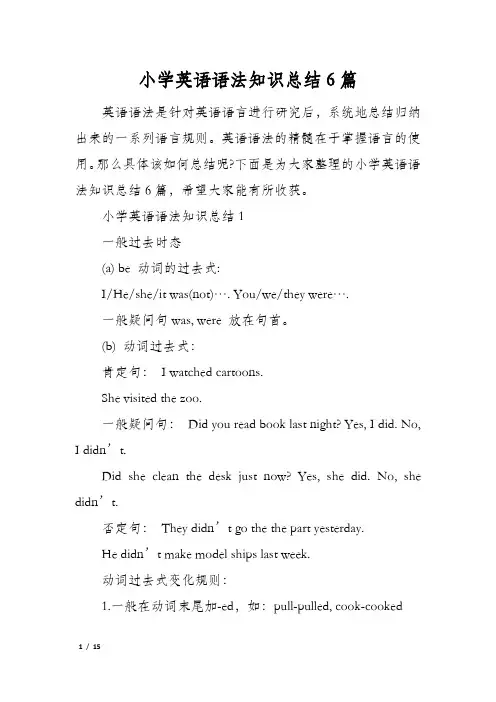
小学英语语法知识总结6篇英语语法是针对英语语言进行研究后,系统地总结归纳出来的一系列语言规则。
英语语法的精髓在于掌握语言的使用。
那么具体该如何总结呢?下面是为大家整理的小学英语语法知识总结6篇,希望大家能有所收获。
小学英语语法知识总结1一般过去时态(a) be 动词的过去式:I/He/she/it was(not)…. You/we/they were….一般疑问句was, were 放在句首。
(b) 动词过去式:肯定句:I watched cartoons.She visited the zoo.一般疑问句:Did you read book last night? Yes, I did. No, I didn’t.Did she clean the desk just now? Yes, she did. No, she didn’t.否定句:They didn’t go the the part yesterday.He didn’t make model ships last week.动词过去式变化规则:1.一般在动词末尾加-ed,如:pull-pulled, cook-cooked2.结尾是e加d,如:taste-tasted3.末尾是辅音字母加一个元音字母和一个辅音字母的重读闭音节,应双写末尾的辅音字母,再加-ed,如:stop-stopped4.以“辅音字母+y”结尾的,变y为i,再加-ed,如:study-studied5.不规则动词过去式:am,is-was,are-were,do-did,see-saw,say-said,give-gave,get-got,go-went,come-came,have-had,eat-ate,take-took,run-ran,sing-sang,put-put,make-made,read-read,write-wrote,draw-drew,drink-drank,swim-swam,sit-sat小学英语语法知识总结2动词加ing的变化规则1.一般情况下,直接加ing,如:cook-cooking2.以不发音的e结尾,去e加ing,如:make-making, taste-tasting3.如果末尾是辅音字母加一个元音字母和一个辅音字母,双写末尾的辅音字母,再加ing,如:run-running, stop-stopping 现在进行时,用来表示正在进行或发生的动作。
小学一到六年级英语语法知识点汇总
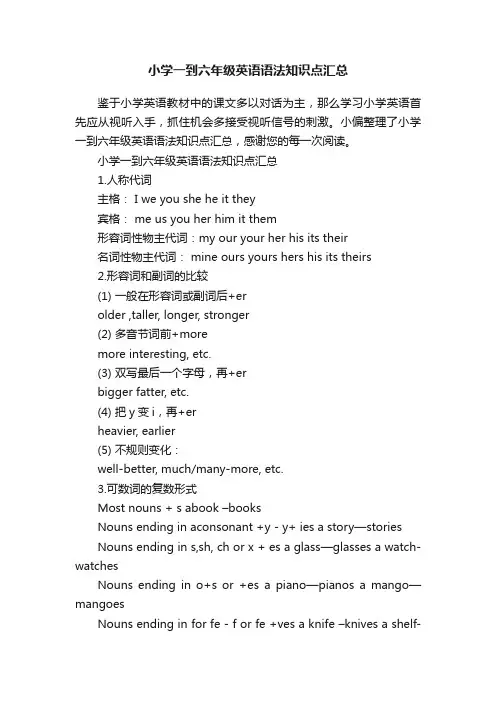
小学一到六年级英语语法知识点汇总鉴于小学英语教材中的课文多以对话为主,那么学习小学英语首先应从视听入手,抓住机会多接受视听信号的刺激。
小偏整理了小学一到六年级英语语法知识点汇总,感谢您的每一次阅读。
小学一到六年级英语语法知识点汇总1.人称代词主格: I we you she he it they宾格: me us you her him it them形容词性物主代词:my our your her his its their名词性物主代词: mine ours yours hers his its theirs2.形容词和副词的比较(1) 一般在形容词或副词后+erolder ,taller, longer, stronger(2) 多音节词前+moremore interesting, etc.(3) 双写最后一个字母,再+erbigger fatter, etc.(4) 把y变i,再+erheavier, earlier(5) 不规则变化:well-better, much/many-more, etc.3.可数词的复数形式Most nouns + s abook –booksNouns ending in aconsonant +y - y+ ies a story—storiesNouns ending in s,sh, ch or x + es a glass—glasses a watch-watchesNouns ending in o+s or +es a piano—pianos a mango—mangoesNouns ending in for fe - f or fe +ves a knife –knives a shelf-shelves4.不可数名词(单复数不变)bread, rice, water ,juice等。
5.缩略形式I’m= I a,you’re = you are,she’s= she is,he’s = he isit’s= it is,who’s =who is,can’t =can not,isn’t=is not等。
小学生英语语法笔记(自己整理)
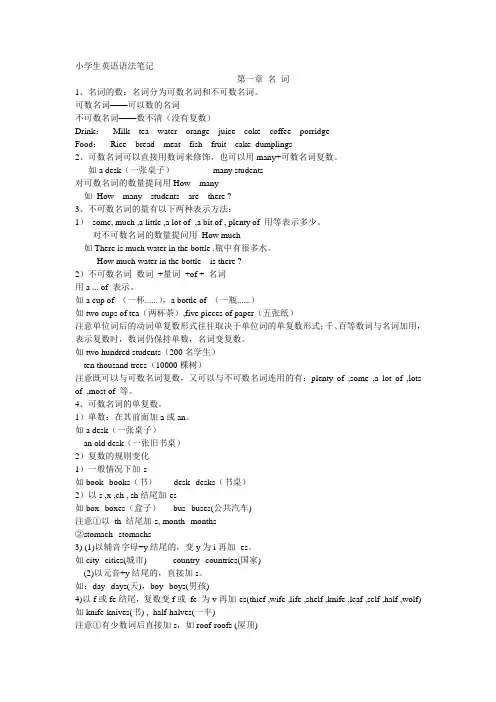
小学生英语语法笔记第一章名词1、名词的数:名词分为可数名词和不可数名词。
可数名词——可以数的名词不可数名词——数不清(没有复数)Drink:Milk tea water orange juice coke coffee porridgeFood:Rice bread meat fish fruit cake dumplings2、可数名词可以直接用数词来修饰,也可以用many+可数名词复数。
如a desk(一张桌子)many students对可数名词的数量提问用How many如How many students are there ?3、不可数名词的量有以下两种表示方法:1)some, much ,a little ,a lot of ,a bit of , plenty of 用等表示多少。
对不可数名词的数量提问用How much如There is much water in the bottle .瓶中有很多水。
How much water in the bottle is there ?2)不可数名词数词+量词+of + 名词用a ... of 表示。
如a cup of (一杯......),a bottle of (一瓶......)如two cups of tea(两杯茶),five pieces of paper(五张纸)注意单位词后的动词单复数形式往往取决于单位词的单复数形式;千、百等数词与名词加用,表示复数时,数词仍保持单数,名词变复数。
如two hundred students(200名学生)ten thousand trees(10000棵树)注意既可以与可数名词复数,又可以与不可数名词连用的有:plenty of ,some ,a lot of ,lots of ,most of 等。
4、可数名词的单复数。
1)单数:在其前面加a或an。
如a desk(一张桌子)an old desk(一张旧书桌)2)复数的规则变化1)一般情况下加-s如book--books(书)desk--desks(书桌)2)以s ,x ,ch , sh结尾加-es如box--boxes(盒子)bus--buses(公共汽车)注意①以th 结尾加-s, month--months②stomach--stomachs3) (1)以辅音字母+y结尾的,变y为i再加- es。
小学语法大全(最新整理)
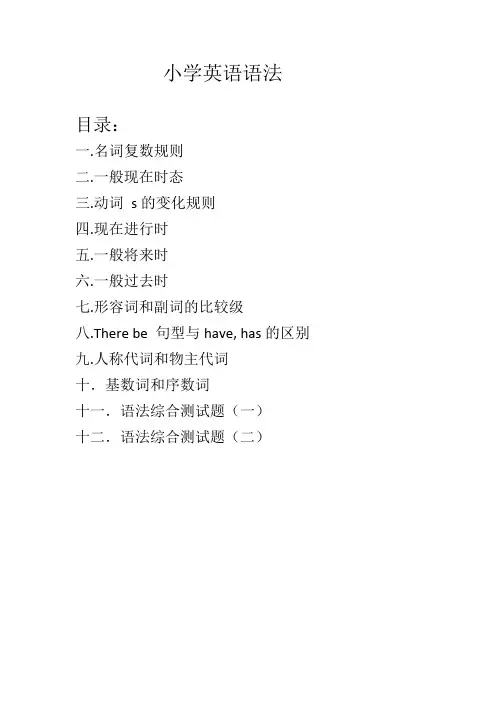
小学英语语法目录:一.名词复数规则二.一般现在时态三.动词s的变化规则四.现在进行时五.一般将来时六.一般过去时七.形容词和副词的比较级八.There be 句型与have, has的区别九.人称代词和物主代词十.基数词和序数词十一.语法综合测试题(一)十二.语法综合测试题(二)第一课时名词复数规则1.一般情况下,直接加-s,如:book-books, bag-bags, cat-cats, bed-beds2.以s. x. sh. ch结尾,加-es, 如:bus-buses, box-boxes, brush-brushes, watch-watches3.以“辅音字母y”结尾,变y为i, 再加-es,如:family-families, strawberry-strawberries4.以“f或fe”结尾,变f或fe为v, 再加-es,如:knife-knives leaf——leaves5.不规则名词复数:man-men woman-women child-children foot-feet tooth-teeth fish-fish people-people sheep-sheep Chinese-Chinese Japanese-Japanese写出下列各词的复数I _____ him ____ this _______ her ____ watch ___ child ____ photo ___ diary ___ day______ foot_____ book_____ dress ____ tooth____ sheep ____ box_____ strawberry _____ thief _____ you _____ peach___ sandwich ___ man_____ woman___第二课时一般现在时一般现在时基本用法介绍:一般现在时的功能1.表示事物或人物的特征、状态。
小学英语语法重点知识归纳大全
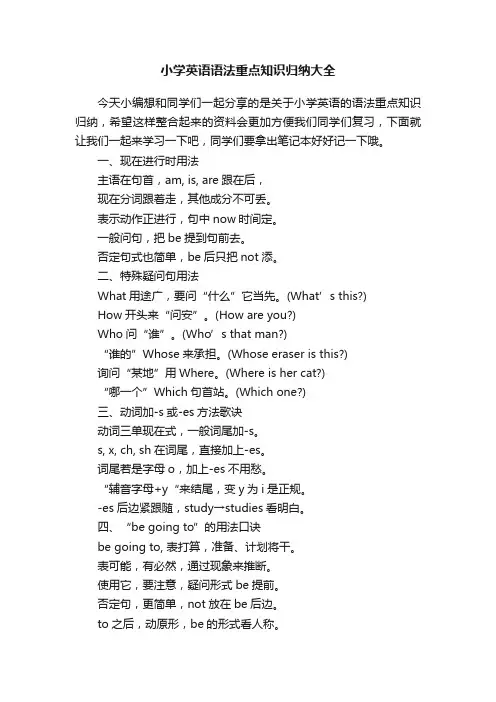
小学英语语法重点知识归纳大全今天小编想和同学们一起分享的是关于小学英语的语法重点知识归纳,希望这样整合起来的资料会更加方便我们同学们复习,下面就让我们一起来学习一下吧,同学们要拿出笔记本好好记一下哦。
一、现在进行时用法主语在句首,am, is, are跟在后,现在分词跟着走,其他成分不可丢。
表示动作正进行,句中now时间定。
一般问句,把be提到句前去。
否定句式也简单,be后只把not添。
二、特殊疑问句用法What用途广,要问“什么”它当先。
(What’s this?)How开头来“问安”。
(How are you?)Who问“谁”。
(Who’s that man?)“谁的”Whose来承担。
(Whose eraser is this?)询问“某地”用Where。
(Where is her cat?)“哪一个”Which句首站。
(Which one?)三、动词加-s或-es方法歌诀动词三单现在式,一般词尾加-s。
s, x, ch, sh在词尾,直接加上-es。
词尾若是字母o,加上-es不用愁。
“辅音字母+y“来结尾,变y为i是正规。
-es后边紧跟随,study→studies看明白。
四、“be going to”的用法口诀be going to, 表打算,准备、计划将干。
表可能,有必然,通过现象来推断。
使用它,要注意,疑问形式be提前。
否定句,更简单,not放在be后边。
to之后,动原形,be的形式看人称。
下列词,要注意,come go和离去(leave)进行时,表将来,牢牢记住莫忘记。
小学英语知识重点一、形容词性物主代词1、形容词性物主代词8个:My your his her its our your their我的你的他的她的它的我们的你们的他(她、它)们的2、形容词性物主代词的特点:1)译成汉语都有"的" eg:my 我的 their 他们的2)后面加名词:eg:my backpack his name3)前后不用冠词 a an theThis is a my eraser(错误)That is your a pen(错误)It's his the pen(错误)3、I(物主代词)my you(物主代词)your he (物主代词)her we (物主代词) our注:在变物主代词时,把原题所给的词加上的,再译成单词就可以了。
(超详)小学英语知识点归纳汇总

(超详)小学英语知识点归纳汇总
1. 语法知识点
- 主谓一致:主语和谓语动词在人称和数上保持一致。
- 形容词和副词的比较级和最高级:用于比较两个或多个事物的形容词和副词的变化形式。
- 名词的单复数:名词变化形式表示单数或复数。
- 时态:表示动作发生的时间,包括现在时、过去时和将来时等。
2. 词汇知识点
- 常用的基础词汇:包括数字、颜色、家庭成员、动物、食物等基本词汇。
- 动词:常用的动词及其过去式和现在分词形式。
- 名词:常见的名词及其单数和复数形式。
- 形容词和副词:用于描述事物的形容词和表示方式的副词。
3. 句型知识点
- 祈使句:用于表达命令、请求或建议的句子。
- 选择疑问句:用于提问时给出的选择项。
- 陈述句:陈述一个事实或描述一个情况的句子。
- 疑问句:用于提出问题的句子。
4. 阅读知识点
- 词义猜测:通过上下文推测词语的意思。
- 主旨理解:理解文章的中心思想或要点。
- 细节理解:理解文章中的具体细节信息。
- 推理判断:根据已有信息推断出未提及的信息。
以上是小学英语的一些基本知识点归纳汇总,希望对您有帮助!。
小学英语语法知识点归纳总结大全
小学英语语法知识点归纳总结大全英语语法是学习英语的基础,对于小学生来说尤为重要。
掌握英语语法知识可以帮助小学生正确使用语言,增强语言表达能力。
为了帮助小学生更好地学习英语语法,以下是一些常见的小学英语语法知识点的归纳总结。
一、名词(Noun)名词是用来表示人、物、地点、动物、植物等事物的词语。
名词分为可数名词和不可数名词。
1. 可数名词:表示可以一种一种数的事物。
例子:book(书)、cat(猫)、apple(苹果)2. 不可数名词:表示不能一种一种数的事物。
例子:water(水)、milk(牛奶)、rice(米饭)名词的复数形式:- 大多数名词在词尾加s形成复数形式。
例子:books(书)、cats(猫)、apples(苹果)- 以s, x, sh, ch结尾的名词,在词尾加es形成复数形式。
例子:buses(公交车)、boxes(盒子)、watches(手表)- 以辅音字母+y结尾的名词,变y为i,再加上es形成复数形式。
例子:babies(婴儿)、flies(苍蝇)、berries(浆果)二、代词(Pronoun)代词是用来代替名词的词语。
代词可以分为主格代词、宾格代词和物主代词。
1. 主格代词:在句子中担任主语的代词。
例子:I(我)、you(你)、he(他)2. 宾格代词:在句子中担任宾语的代词。
例子:me(我)、you(你)、him(他)3. 物主代词:表示所属关系的代词。
例子:my(我的)、your(你的)、his(他的)三、动词(Verb)动词是表示动作、状态或存在的词语。
动词分为及物动词和不及物动词。
1. 及物动词:需要接宾语来完成意义的动词。
例子:eat(吃)、drink(喝)、watch(观看)2. 不及物动词:不需要接宾语就能完成意义的动词。
例子:run(跑)、sleep(睡觉)、sit(坐)动词的时态:- 一般现在时:表示经常性或习惯性的动作。
例子:I eat breakfast every morning.(我每天早上吃早餐。
小学英语语法归纳总结-小学英语知识点归纳
小学英语语法归纳总结-小学英语知识点归纳1. 句子结构:- 陈述句:主语 + 动词 + 宾语- 疑问句:疑问词/助动词 + 主语 + 动词 + 宾语?- 否定句:主语 + 助动词 + not + 动词 + 宾语2. 时态:- 现在时:主语 + 动词原形(第三人称单数要加s)- 过去时:主语 + 动词过去式(一般直接加ed,不规则动词需变换)- 将来时:主语 + will + 动词原形3. 名词:- 可数名词:可以单独计数的名词,有单数和复数形式- 不可数名词:不能单独计数的名词,只有单数形式- 可数名词复数形式:一般在名词末尾加s,以s, x, ch, sh等结尾的名词加es,以辅音字母+y结尾的名词变y为i,再加es- 特殊名词复数形式:不规则变化,如man - men, woman - women4. 代词:- 主格代词:用于作主语,如I, you, he, she, it, we, they- 宾格代词:用于作宾语,如me, you, him, her, it, us, them- 形容词性物主代词:用于表示所有关系,如my, your, his, her, its, our, their- 名词性物主代词:用于替代名词,如mine, yours, his, hers, its, ours, theirs5. 动词:- 基本动词:表示基本动作或状态的词汇,如play, run, eat- 助动词:用来辅助构成时态、人称、语态等形式,如be, do, have- 行为动词与非行为动词:行为动词表示具体的行动,如swim, dance,非行为动词表示状态或感觉,如like, love6. 形容词和副词:- 形容词:描述名词的词,用于修饰名词,一般放在名词前面,如big, small- 副词:描述动词、形容词或其他副词的词,用于修饰动词、形容词或其他副词,一般放在动词或形容词前面,如quickly, well7. 介词:- 介词的作用是连接名词或代词与其他词语,表示一种关系,如in, on, under8. 连词:- 并列连词:用于连接并列的词、短语或句子,如and, but, or- 从属连词:用于引导从句,如because, if, when以上是小学英语语法的基本知识点的归纳总结。
小学英语语法知识点五篇
【导语】英语语法是针对英语语⾔进⾏研究后,系统地总结归纳出来的⼀系列语⾔规则。
英语语法的精髓在于掌握语⾔的使⽤。
以下是⽆忧考整理的《⼩学英语语法知识点五篇》相关资料,希望帮助到您。
1.⼩学英语语法知识点 不可数名词(单复数形式不变) bread, rice, water ,juice etc. 缩略形式 I'm = I am you're = you are she's = she is he's = he is it's = it is who's =who is can't =can not isn't=is not etc a/an a book, a peach an egg an hour Preposition: on, in ,in front of, between, next to, near, beside, at, behind. 表⽰时间: at six o'clock, at Christmas, at breakfast on Monday on 15th July On National Day in the evening in December in winter 基数词和序数词 one - first two-second twenty-twentieth Some /any I have some toys in my bedroom. Do you have any brothers or sisters?2.⼩学英语语法知识点 (⼀)情态动词can can 在英语中有⼀个特殊的名字,叫做情态动词,表⽰“能够”, “会”, “能⼒”后⾯要跟着表⽰动作的动词。
没有时态和⼈称的变化。
表⽰不能做什么的时候,后⾯加上 not为can not,或者缩写为can’t。
问别⼈“能…吗?”要把can 放在句⼦前⾯,⾸字母要⼤写,句尾别忘加上问号。
小学英语时态语法重点难点整理
小学英语时态语法重点难点整理1、一般现在时(1)句中be动词和动词一般情况下只能有一种而且也必须有一种。
如:The children are very happy on Christmas Day .(2)一般现在时中的be动词:一般用原形:am is aream用于第一人称单数(I);is用于第三人称单数(he she it和其他人名或称谓,如:Ben his sister等);are用于第二人称单数(you)和所有复数(包括第一人称复数we、第二人称复数you;第三人称复数they和其他复数,如the children 、his parents等)。
(3)一般现在时中的动词:有两种情况:第一种情况:主语是第三人称单数(he she it和其他,如Helen 、her cousin等),动词后一般加s或es。
第二种情况:主语不是第三人称单数,动词都用原形。
2、一般过去时(1)句中be动词和动词一般情况下只能有一种而且也必须有一种。
如:The girls were on the grass just now .They visited my parents last weekend .(2)一般过去时中的be动词:一般用过去式:was werewas用于第一人称单数(I)和第三人称单数(he she it和其他人名或称谓,如:Ben 、his sister等);were用于第二人称单数(you)和所有复数(包括第一人称复数we、第二人称复数you;第三人称复数they和其他复数,如the children 、his parents等)。
(3)一般过去时中的动词:一般只有一种情况:+ed这里强调一点,和一般现在时不同的是这里不管主语是第几人称,也不管是单数和复数都加ed。
(4)有用的的依据:Be动词是was或were该句是一般过去时动词加ed有表示过去的时间状语3、一般将来时(1)构成形式:Be going to +动词原形。
- 1、下载文档前请自行甄别文档内容的完整性,平台不提供额外的编辑、内容补充、找答案等附加服务。
- 2、"仅部分预览"的文档,不可在线预览部分如存在完整性等问题,可反馈申请退款(可完整预览的文档不适用该条件!)。
- 3、如文档侵犯您的权益,请联系客服反馈,我们会尽快为您处理(人工客服工作时间:9:00-18:30)。
小学英语语法点整理
1.人称代词
主格:I we you she he it they
宾格:me us you her him it them 形容词性物主代词:my our your her his its their
名词性物主代词:mine ours yours hers his its theirs
2.形容词和副词的比较级
(1) 一般在形容词或副词后+er older taller longer stronger
(2)多音节词前+more more interesting,
(3)双写最后一个字母,再+er bigger fatter,
(4) 把y变i,再+er heavier, earlier
(5) 不规则变化:well-better, much/many-more,
3.可数词的复数形式
直接+ s a book –books
辅音字母+y - y+ ies a story—stories
以s, sh, ch ,x 结尾+ es a glass—glasses a watch-watches
以o结尾,无生命+s 有生命+es a piano—pianos a mango—mangoes 以f或fe结尾- f 或fe变ves a knife –knives a shelf-shelves
4.不可数名词:bread, rice, water ,juice等。
5.缩略形式
I’m = I am you’re = you are she’s = she is he’s = he is
it’s = it is who’s =who is can’t =can not isn’t=is not etc
6. a/an a book, a peach an egg an hour
7. Preposition介词:
on, in ,in front of, between, next to, near, beside, at, behind.
表示时间:at six o’clock, at Christmas, at breakfast
on Monday on 15th July On National Day
in the evening in December in winter in 2012
8.基数词和序数词
(1)写法与变法one –first two-second twenty-twentieth
(2)※几十几百数字的读法
(3)用法:①基+基====表示时间(时间表达法)
②the+序数词
9. Some /any I have some toys in my bedroom.
Do you have any brothers or sisters?
10. be动词
(1)be 动词am/are/is
(2) 肯定和否定句I am(not) from London.
My eyes are(not) small. My hair is(not) long.
(3)一般疑问句:Are you a Chniese? Yes, I am. No, I am not.
Are they reading? Yes, they are. No, they aren’t.
Is your math teacher strict? Yes, he is. No, he isn’t.
11. there be结构
肯定句:There is a\an …
There are …
否定句:There isn’t …. There aren’t….
一般疑问句:Is there …? Yes, there is./ No, there isn’t.
Are there…? Yes, there are. /No, there aren’t.
12.祈使句
Sit down please
Don’t sit down, please.
13. (情态)动词can,must, should后面直接用动词原形。
eg:1. I / He / She / They can sing.
2.You should keep quiet in the library.
14.现在进行时.通常用“now,look listen”.
形式:be + v +ing
eg: I am(not) doing my homework.
You/We/They are(not) reading.
He/She/It is(not) eating.
动词—ing 的形式
直接+ing walk—walking
去e + ing come—coming
双写run+ ing –running swim—swimming
15一般现在时。
通常用“usually, often, every day, sometimes”。
肯定句:I go to school on foot every day.
She goes to school on foot every day.
一般疑问句:
Do you jump high? Yes, I do. / No, I don’t.
Does he jump high? Yes, he does. / No, he doesn’t.
否定句:We don’t go to school on Sundays.
My mother doesn’t like watching TV in the evening.
16.一般过去时态(yesterday,last weekend ,last year ,,,)
(a)be 动词的过去式:
I/He/she/it was(not)…. You/we/they were….
一般疑问句was, were 放在句首。
(b)动词过去式:
肯定句:I watched TV last night.
She visited her grandparents.
一般疑问句:Did you read books last night? Yes, I did. No, I didn’t. Did she clean the room just now? Yes, she did. No, she didn’t.
否定句:They didn’t go the the part yesterday.
He didn’t play football last week.
(3)动词过去式的变化:
规则动词的变化:直接+ed eg. planted,watered,climbed。
以e +d eg. liked。
辅音字母+y结尾--y +ied eg : study—studied
一辅重闭,双写辅音字母+ed eg: stop --stopped
不规则动词的变化:is/am—was,are—were,do—did,have/has—had,make —made,fly-flew eat—ate,take—took,run—ran,sing—sang,drink—drank
17.一般将来时(tomorrow ,next weekend)
A)be going to +v.原变否定在be 后加not,变疑问把be 提前放句首
B)will +v.原变否定在will后加not,(won't),变疑问把will提前放句首
18.“Wh-”questions.
1)What's your name ?
2)How old are you?
3)What does your father do?
4)Which season do you like best?
5)When do you get up in the morning?
6)What would you like for lunch?
7)What’s your English teacher like?
8)What will you be when you grow up?
9)Where are you going on your holiday?
10)What are you doing?
11)What colour is it?
12)Which is your watch, the yellow one or the white one?
13)How much is the toy bear?。
